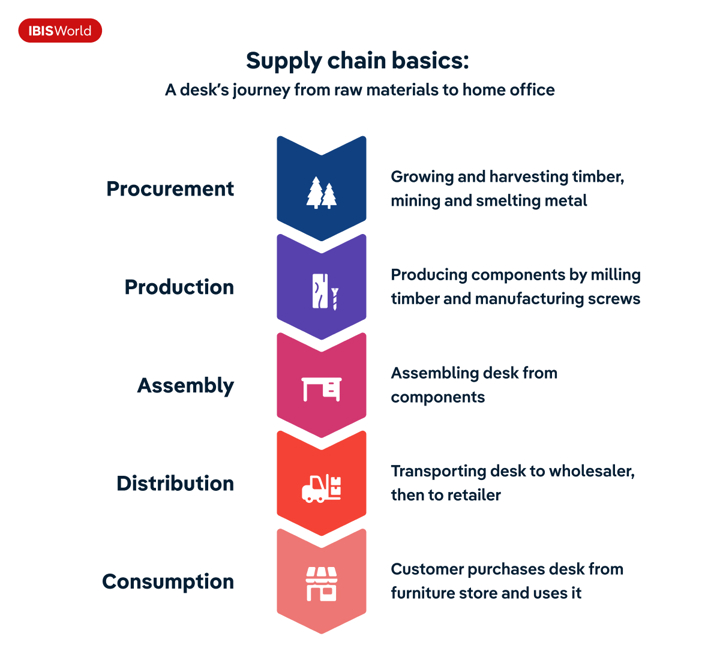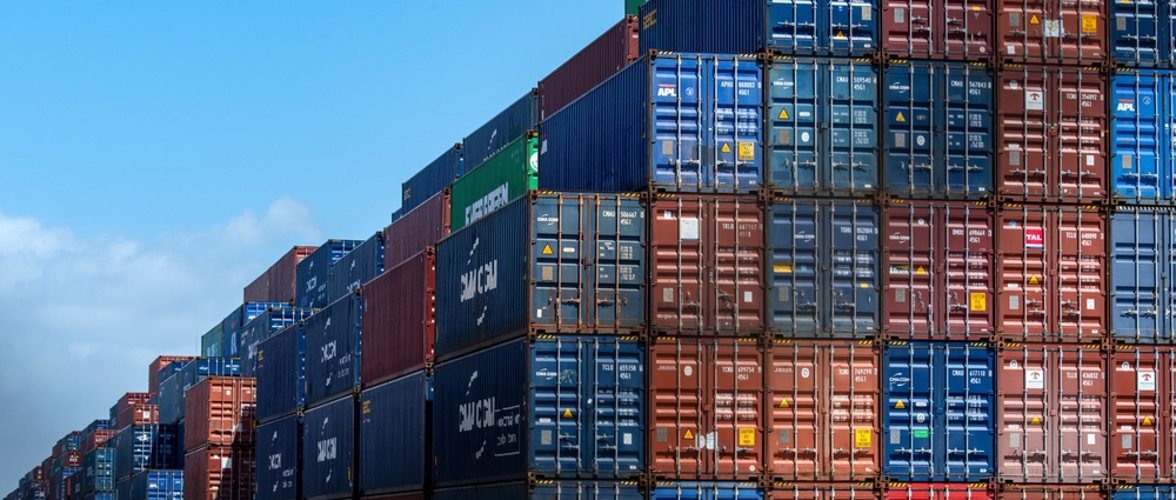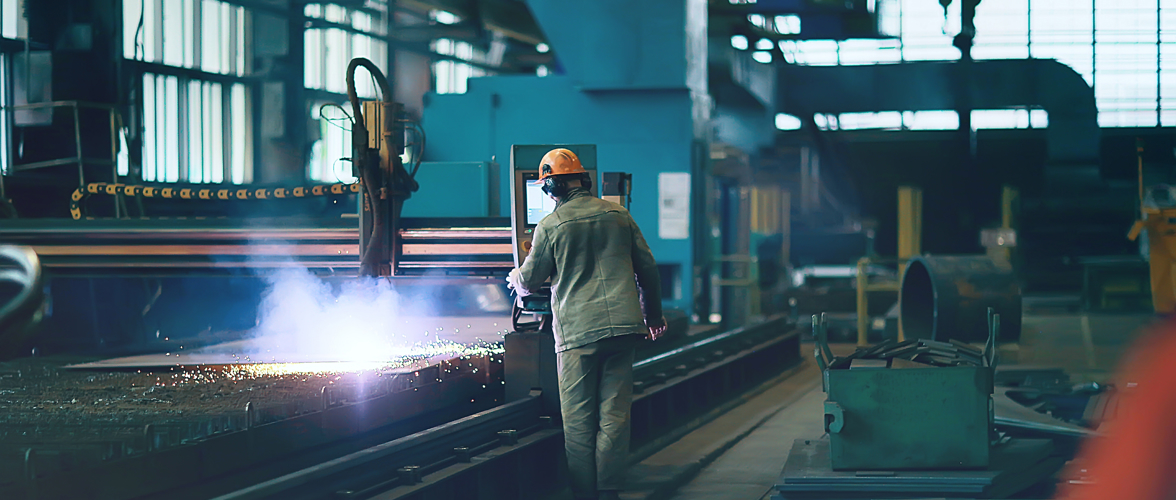Key Takeaways
- Supply chains encompass the entire process of creating a product, from the production of raw materials to the sale of goods or services to consumers.
- Well-managed supply chains can improve profitability, efficiency and customer relationships.
- The complexity of modern supply chains leaves them vulnerable to disruptions, which makes effective risk analysis and supply chain management crucial to success.
Supply chains function at the core of business operations and shape the success of industries worldwide. Whether you’re running a small business or working in procurement for a multinational corporation, understanding – and properly managing – your supply chain is critical. Let’s start at the beginning.
What are supply chains?
Supply chains are dynamic systems made up of stages that, collectively, connect raw materials to end consumers. Every stage is essential for business operations and they are all interdependent, requiring careful management to create a seamless flow of goods.
What are the stages in the supply chain?
Each supply chain is different depending on the goods or services being produced, but they generally follow the same path. To break down the interconnected stages in a typical supply chain, we’ll use a wooden desk as an example product.

Procurement
Sourcing the raw materials that make up the product is the first stage in the supply chain. If the product is a service, the first stage involves procuring the equipment needed to perform the service. In the desk example, procurement would include growing and harvesting the timber used to form the structure of the desk, and mining and smelting the metals needed for the screws and any metal fastenings.
Production
The raw materials then progress to the manufacturers that produce the components of the end product. A wood producer might take timber logs and cut them to size, while a metal fabricator turns spools of metal wire into screws.
Assembly
In this stage of the supply chain, product manufacturers assemble the components. In our example, a manufacturer would build the desk using the wood and screws or metal parts. The manufacturer in this stage might instead predrill holes and stack the finished wood to create a flat package that ships with the necessary screws.
Distribution
After manufacturing, the finished product needs to reach the end user. This is where distribution comes in. Depending on a company’s business model, the product may be routed via wholesalers to retailers or it may ship directly from manufacturers to retailers – and even consumers. In this example, the manufacturer sells the desk to a wholesaler who then sells it to a furniture store.
Consumption
Consumption of the product, whether a good or service, is the final stage in a typical supply chain. In this step, a consumer purchases a product from a retailer (or directly from a manufacturer) for individual use, or purchases and uses a service from a service provider. For example, in this step a customer goes to a furniture store and purchases the desk to use in a home office.
How do supply chains vary across industries?
Supply chains can vary drastically depending on the product or service being produced. Broadly speaking, products tend to follow a similar supply chain as the wooden desk example, although complex products like machinery or electronics naturally involve more components from a wider array of sources.
The supply chain for a service is slightly different, in that clients or customers aren’t purchasing a physical product. For instance, in the tech industry, software development replaces the production stage, while cloud-based access and consumer downloads represent distribution and consumption. Understanding service supply chains requires a shift in perspective, focusing less on physical flow and more on the flow of information and interactions that create and deliver value to the customer.
Why are supply chains important in business?
Supply chains are more than just a way to move products: they function as critical channels that connect companies with their customers. Supply chains are also a key component of a business’ strategy, and can substantially affect profitability and customer relationships.
Efficiency and profitability
Ultimately, planning the most efficient strategy to get from raw material to end consumer can save resources – including time – and minimize stress. An optimized supply chain leads to operational efficiency, which in turn improves profitability by reducing costs associated with production, transportation and storage.
Customer satisfaction
Supply chains also directly affect the customer experience. A well-managed supply chain ensures that customers receive products quickly, at the price and quality they’re looking for. Getting these aspects right improves customer satisfaction and helps build customer loyalty.
Competitive advantage
Having an effective supply chain can be a significant competitive advantage. Companies stand out from the competition when they deliver products faster and with fewer errors, at a higher quality or at a lower cost.
Risk management
By integrating risk analysis into supply chain planning, businesses can identify potential weaknesses or disruptions in the chain and implement pre-emptive measures to avoid or minimize damage. If you’re a supply chain manager or procurement professional, you’ll want to consider implementing a risk management framework.
How does the concept of supply and demand affect supply chains?
The economic principle of supply and demand reflects the relationship between the availability, or supply, of a particular product and the demand or desire for it among consumers at various prices. The principle has a significant effect on supply chains.
A range of factors can influence supply, including raw material availability, production cost, labor market dynamics and technology advancements. Consumer preferences, income levels, and price of substitute goods are some of the factors that affect demand. Returning to the desk example, supply might decline if a major manufacturer goes bankrupt – or increase if new, low-cost manufacturers enter the industry. Meanwhile, demand might decrease if consumer confidence or incomes fall, or increase if more people start to work from home.
In an ideal market scenario, the intersection of supply and demand determines the price of the product or service. Understanding this principle is crucial for effective supply chain management as it helps businesses forecast market trends, improve inventory levels and make strategic decisions to ensure profitability and customer satisfaction.
What is supply chain management?
Supply chain management (SCM) is all about overseeing and optimizing the flow of goods, data and finances as they move between suppliers, manufacturers, wholesalers, retailers and consumers. At its core, SCM aims to maximize efficiency and minimize costs.
Supply chain managers use a range of strategies and tools to achieve these goals:
- Demand forecasting predicts whether customers will want a product or service, how much they’ll purchase and what they’re willing to pay for it. Performing this analysis will mean that businesses can have enough stock or service capacity to meet demand while at the same time reducing waste by not overstocking or having more staff and infrastructure than is necessary.
- Inventory management ensures a company has enough product on hand (or staff to provide services) to meet demand – but not too much.
- Logistics planning helps supply chain managers figure out the most cost-effective way to get products from point A to point B (and then to point C, point D and beyond).
Supply chain management is a complex juggling act that requires careful coordination, strategic planning and meticulous execution. When done well, it can reduce costs, improve efficiency and increase customer satisfaction – a win-win for businesses and customers.
Challenges in supply chains
Supply chain managers and procurement professionals face many challenges on a day-to-day basis, simply due to supply chains’ complex nature.
Demand forecasting
One of the biggest challenges in supply chain management is demand forecasting. Accurate demand forecasting is crucial for maintaining the right inventory levels and preventing waste. However, it’s often difficult to execute due to factors like changing market trends, fluctuating economic conditions and unpredictable consumer behavior. A retailer deciding how many desks to order, for example, needs to consider factors like the number of people currently buying desks, whether that is likely to change based on the time of year and how quickly customers’ design preferences will change.
Supplier relationship management
Businesses often need to deal with multiple suppliers – each with their own timelines, quality standards and delivery processes. Coordinating all these elements to ensure a smooth flow of materials is an ongoing challenge. A furniture manufacturer buying screws to assemble a desk might have plenty of suppliers to choose from but will have to weigh things like the quality of the screws, where they were made and how cost-effective they are, in addition to whether and how to maintain relationships with multiple suppliers in case of disruptions.
ESG factors
Environmental, social and governance (ESG) has become an important consideration as governments introduce and tighten legislation regarding environmental impacts and human rights, and consumers base more of their purchasing decisions on ethical, social and environmental concerns. Businesses are increasingly expected to reduce waste, minimize their carbon footprint and ensure ethical sourcing. But achieving these sustainability goals while maintaining cost-effectiveness and a tight grip on efficiency can be challenging. Questions consumers might ask about the desk, for example, could include:
- Is the timber sustainably sourced?
- Are the workers who assembled the desk paid a living wage?
- Is the packaging recycled or recyclable?
Disruptions in supply chains
While our earlier desk example was relatively straightforward, the reality is that most supply chains are very complex, which makes them susceptible to disruptions. Every component within every stage is part of its own interconnected supply chain: from the logging equipment used to harvest timber to the computers that supply chain managers use to order materials, to the trucks that transport the finished desk to the furniture store. This also means that there are multiple ways that every stage can go wrong, with the potential to create severe bottlenecks.
Disruptions might occur due to:
- raw materials shortages, either because of a sudden decrease in supply as a result of natural disasters, conflicts or crop failures, or a significant increase in consumer demand in response to an emergency or unexpected trend emerging;
- manufacturing standstills like factory closures linked to equipment failure, fires or financial issues; or
- logistics breakdowns arising from conflicts, worker shortages, international trade disputes or severe weather events like fires or floods.
COVID-19 and supply chains
The COVID-19 pandemic demonstrated how vulnerable supply chains are to disruption. On the supply side, high infection rates and stay-at-home orders meant that many people were unable to work, dramatically reducing manufacturers’ and suppliers’ capacity to produce materials, components and end products. These production decreases had a domino effect across the supply chain: reduced access to raw materials limited component production, which in turn constrained the manufacturing of end products and availability of services.
On the demand side, consumer spending habits changed dramatically. The sudden increase in the number of people working from home caused a spike in demand for home office equipment (like our wooden desk). With limited access to outside entertainment, demand for products like home entertainment systems, game consoles and exercise equipment soared. Meanwhile, demand for medical supplies surged as the pandemic spread, while medical personnel and consumers alike struggled to secure supplies of masks and hand sanitizer.
Supply chains struggled across the board to keep up with the rapid and severe changes in demand, made worse by significant disruptions to production at all stages. Logistics challenges compounded these issues, with circumstances like border closures and infection rates disrupting shipping and freight movements around the globe.
What is the role of technology in supply chains?
Technology plays a pivotal role in the optimization of supply chains and continues to change the way businesses manage them by offering greater efficiency, visibility and accuracy throughout the process.
Communication and coordination
Technology can greatly enhance communication between companies in a supply chain, thereby improving coordination across its different interconnected stages. Digital platforms and cloud computing allow suppliers, manufacturers and retailers to exchange information instantly. This seamless communication helps prevent disruption and ensures smooth transitions from one stage to the next.
Product tracking
Modern technology has also provided the ability to track and trace the movement of products throughout the supply chain. While this improves efficiency by allowing businesses to quickly identify and address any issues that may arise, it also promotes transparency in supply chains, which is becoming increasingly important as legislation and consumer preferences change.
Predictive analytics
Predictive analytics help businesses anticipate demand and manage inventory effectively. By analyzing past trends and market data, businesses can forecast more precisely and make informed decisions about production and distribution.
Automation
Typically the first factor that comes to mind when considering supply chain optimization, automation can reduce manual labor, speed up processes and minimize errors. Depending on the supply chain, automation may include introducing software that manages the planting or harvesting process of grain, for example, or implementing more advanced manufacturing machinery.
Let’s apply these concepts to the wooden desk example. Improved communication technology allows businesses at each stage of the supply chain to exchange materials and information more readily, preventing bottlenecks and reducing the cost of producing the desk. Product tracking allows retailers to provide consumers with information about the working conditions of the people who built the product and whether the timber was sustainably sourced. Predictive analytics allow the manufacturer to determine how many desks to produce and give the retailer insight into how much stock to order, while automation makes the processes of manufacturing the screws or cutting the wood more efficient.
As technology continues to advance, it becomes indispensable for smooth and streamlined operations across supply chains, giving businesses a competitive edge.
Final Word
In many ways, supply chains are the foundation of any business operation, linking raw materials to the end consumer. Effective SCM involves a delicate balance of managing relationships with suppliers, predicting customer demand, mitigating risks and striving for sustainability. Despite their inherent complexity, well-orchestrated supply chains drive efficiency, reduce costs and promote customer satisfaction, making them a critical component of business success.









